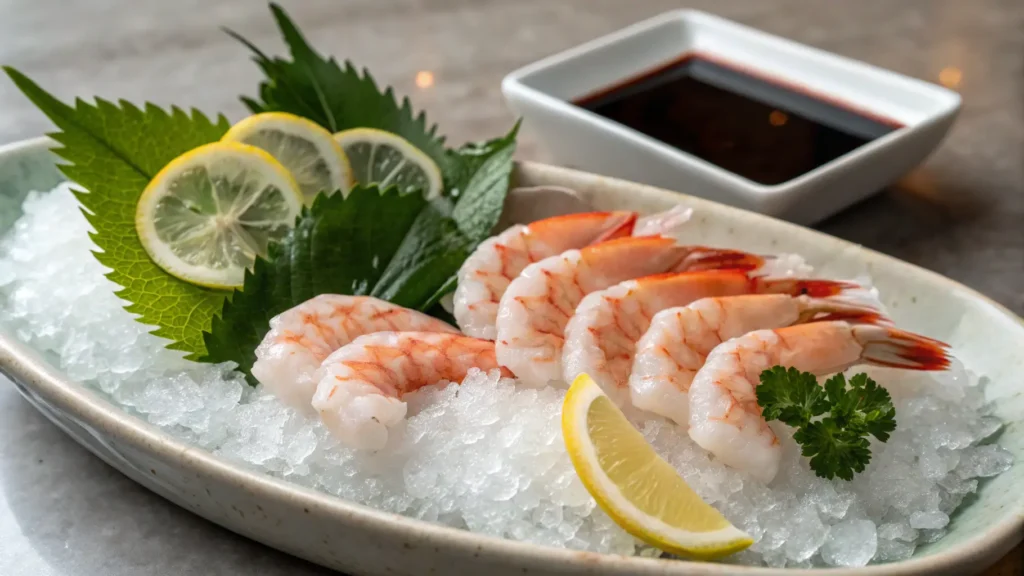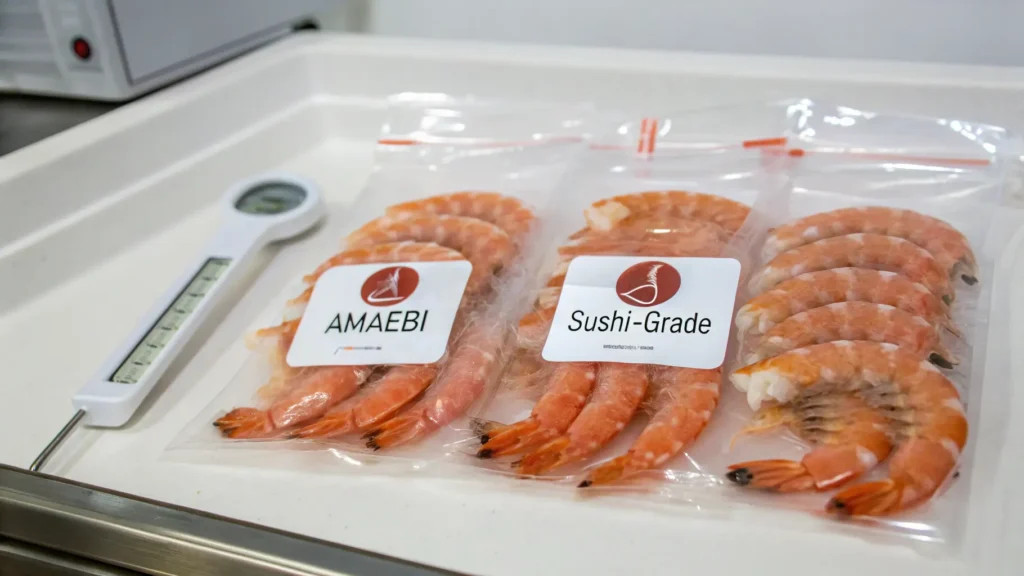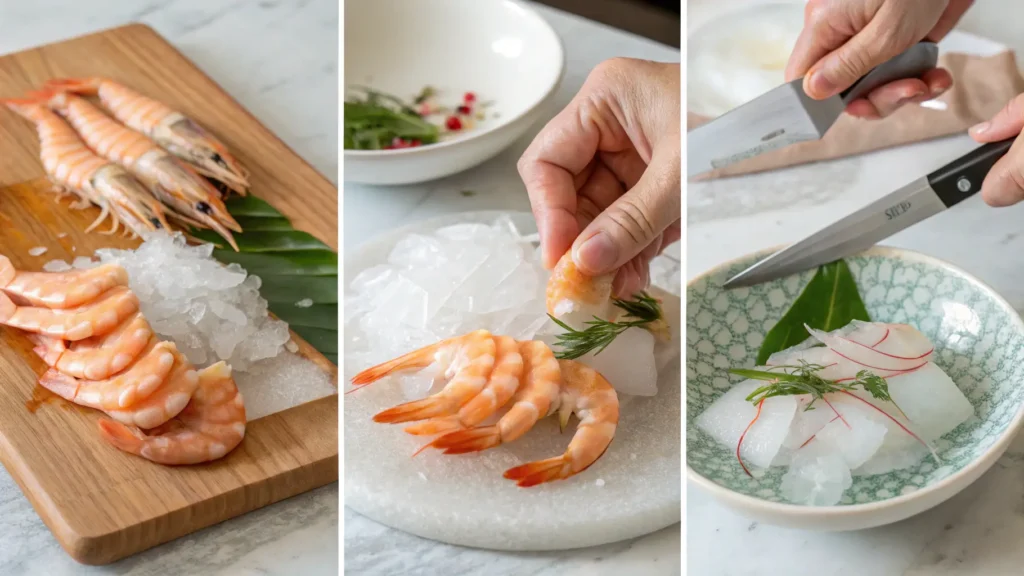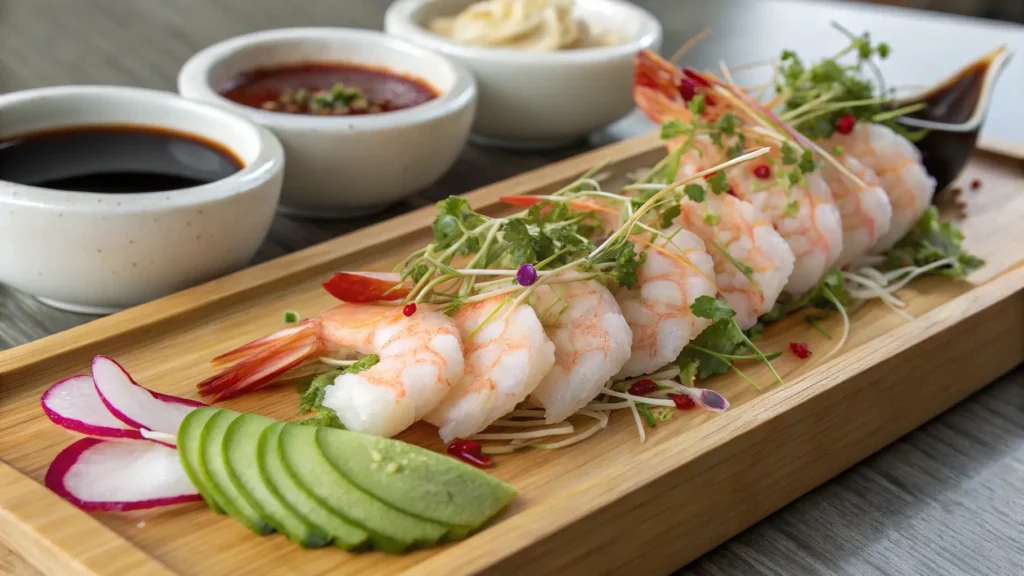Light, delicate, and deeply flavorful, shrimp sashimi is one of the most refined raw seafood dishes in Japanese cuisine. Traditionally served chilled with soy sauce, wasabi, and citrus, sashimi emphasizes purity of taste, of texture, and of technique. And when it comes to shrimp, few proteins deliver such a natural sweetness and elegant mouthfeel when served raw.
At gatetasty, we believe sashimi is more than just raw fish it’s about respecting the ingredient. With Chef Lucas Benetti’s professional method, you’ll learn how to safely prepare shrimp sashimi at home, plate it like a pro, and appreciate every clean, cool bite.

What Is Shrimp Sashimi?
Shrimp sashimi is a raw dish made from very fresh or flash frozen shrimp, usually served sliced and chilled, with minimal seasoning to highlight its natural flavor. In Japanese cuisine, the most common variety is amaebi (sweet shrimp), known for its buttery texture and subtle sweetness.
Unlike sushi, sashimi is served without rice. This places full focus on the shrimp’s taste and texture, often enhanced only with soy, wasabi, or yuzu juice.
Common Characteristics of Shrimp Sashimi:
| Aspect | Details |
|---|---|
| Texture | Soft, delicate, slightly sticky |
| Flavor | Mildly sweet, clean ocean flavor |
| Temperature | Served cold, never warm |
| Typical Shrimp Type | Amaebi (sweet shrimp), Botan ebi, or Spot Prawn |
Chef Lucas Tip: “The best sashimi feels like it melts on your tongue. The shrimp should be chilled, tender, and sweet never chewy or fishy.”
Is Shrimp Sashimi Safe to Eat?
Yes if properly sourced and prepared, shrimp sashimi is safe. However, because shrimp is highly perishable, it’s critical to follow safety guidelines when handling raw seafood.
Food Safety Essentials
| Requirement | Details |
|---|---|
| Sushi grade shrimp | Must be frozen at -4°F (-20°C) for at least 7 days |
| Source from trusted vendor | Use a reputable fishmonger or supplier |
| Avoid farmed tropical shrimp | These often lack proper freezing/safety standards |
| Thaw carefully | In fridge overnight or under cold water |
If in doubt, always ask your seafood supplier if the shrimp is safe for raw consumption. Look for packaging labeled “sashimi grade” or “sushi grade.”

Chef Lucas Benetti’s Approach to Shrimp Sashimi
In the gatetasty kitchen, Chef Lucas Benetti follows a refined, minimalist approach to sashimi. His belief: Let the ingredient speak for itself.
Here’s how Chef Lucas preps sashimi at gatetasty:
- Choose amaebi or spot prawns
Their soft, sweet meat is ideal for raw preparation. - Flash thaw and clean carefully
Keep shrimp cold at all times. Remove shells and veins with care, keeping the tail intact for presentation. - Slice with a sashimi knife
Thin, clean cuts allow the shrimp to lie flat and hold garnishes. - Serve cold on crushed ice
Plate with traditional accompaniments: soy, lemon, wasabi, or yuzu kosho.
Chef Lucas Tip: “I sometimes finish my shrimp sashimi with just a drop of citrus and a few grains of sea salt. No more than that it’s about balance.”
gatetasty’s Shrimp Sashimi Prep Method
Here’s the gatetasty step by step method for preparing perfect shrimp sashimi at home.
Ingredients:
- 6–8 pieces sashimi grade amaebi
- Ice water for chilling
- Shiso leaves, lemon wedges, or daikon garnish
- Dipping sauce: soy sauce, yuzu ponzu, or wasabi
Preparation Steps:
- Thaw shrimp gently
Thaw in the refrigerator overnight or in a sealed bag under cold water. - Peel shrimp
Remove shell and head, leaving tail intact for visual appeal. - Devein
Use a paring knife or toothpick to remove the intestinal vein. - Butterfly or slice
Slice lengthwise from underbelly to create a flat sashimi shape. - Chill
Rinse in ice water briefly and place over crushed ice or cold plate. - Garnish and serve
Plate with lemon, microgreens, daikon, or edible flowers.

Table: Types of Shrimp Used in Sashimi
| Shrimp Type | Flavor Profile | Texture | Region |
|---|---|---|---|
| Amaebi | Sweet, delicate | Very soft | Northern Pacific |
| Botan Ebi | Rich, slightly firmer | Meaty yet tender | Hokkaido, Japan |
| Spot Prawn | Mild, buttery | Silky and juicy | Alaska, Canada |
| Kuruma Ebi | Briny, oceanic | Firm with snap | Japan |
Amaebi (sweet shrimp) is the most common choice for sashimi due to its ultra soft texture and sweetness when served raw.
Serving & Flavor Pairings for Shrimp Sashimi
While sashimi is best kept simple, garnishes and dipping sauces can enhance the overall experience.
Classic Pairings:
| Element | Recommended Options |
|---|---|
| Garnish | Shiso leaf, daikon radish, lemon slice |
| Dipping sauce | Soy sauce, yuzu ponzu, citrus soy |
| Condiments | Wasabi, yuzu kosho, sea salt flakes |
| Sides | Pickled ginger, miso soup, white rice (optional) |
Plating on crushed ice or a chilled plate is essential to maintain freshness and presentation.

Storage and Handling Tips
Raw shrimp spoils fast, so follow these storage rules carefully:
Safe Storage Table
| Storage Method | Details | Shelf Life |
|---|---|---|
| Frozen (vacuum sealed) | Store at -4°F or below | Up to 3 months |
| Thawed (uncooked) | Refrigerate in coldest part of fridge | Use within 24 hours |
| Prepared sashimi | Keep on ice or serve immediately | Best within 1 hour |
Never leave shrimp sashimi at room temperature for extended periods. Always prepare and serve as close to eating time as possible.
FAQs About Shrimp Sashimi
1. Is shrimp sashimi raw?
Yes, shrimp sashimi is typically served raw. However, it must be prepared using sashimi grade shrimp that has been properly frozen to eliminate parasites. The shrimp is served chilled and sliced carefully to highlight its natural sweetness and soft, delicate texture.
2. What kind of shrimp is used for sashimi?
The most common types of shrimp used in sashimi include amaebi (sweet shrimp), botan ebi, kuruma ebi, and spot prawns. These varieties are prized for their tender texture and clean, mildly sweet flavor, which are ideal for raw consumption.
3. Is it okay to eat shrimp raw?
It is okay to eat shrimp raw only if it is sashimi grade and has been frozen at safe temperatures to eliminate harmful bacteria and parasites. Never eat raw shrimp unless it’s specifically labeled for raw consumption and sourced from a trusted supplier.
4. What is the difference between shrimp nigiri and sashimi?
The key difference is that shrimp sashimi is served on its own, while shrimp nigiri is served on top of a small ball of vinegared sushi rice. Sashimi focuses solely on the purity of the seafood, while nigiri is part of sushi, combining seafood with rice and sometimes other toppings.
Conclusion
Shrimp sashimi is more than just a raw dish it’s a celebration of seafood purity, preparation, and presentation. With guidance from Chef Lucas Benetti and the precision focused approach we use at gatetasty, you can serve shrimp sashimi that’s safe, elegant, and unforgettable.
Start with the right shrimp, treat it with care, and let its delicate flavor shine. Whether you’re building a sashimi platter or serving a light appetizer, shrimp sashimi offers a touch of gourmet luxury with minimal ingredients.
For more seafood how tos and expert prep tips, visit gatetasty.com where flavor meets finesse.




